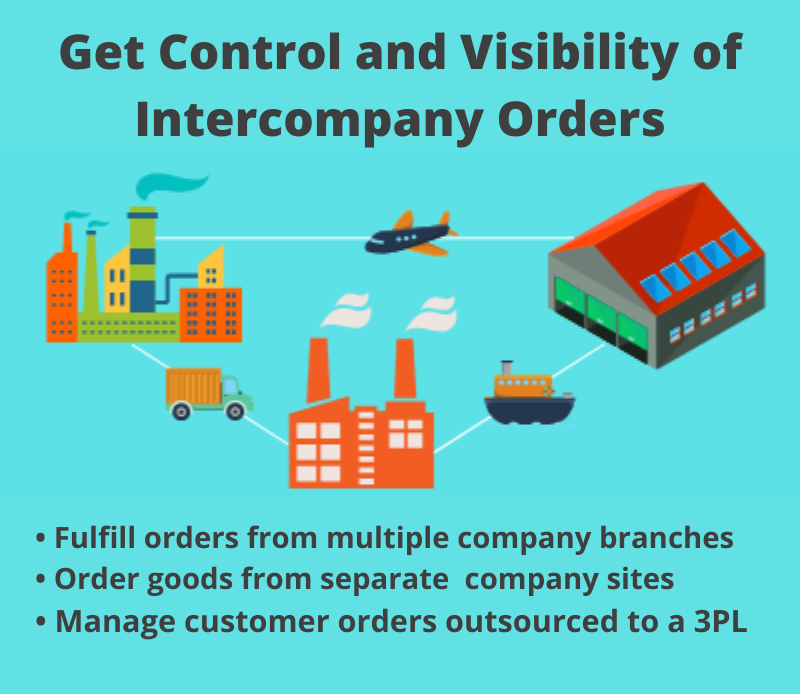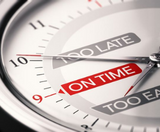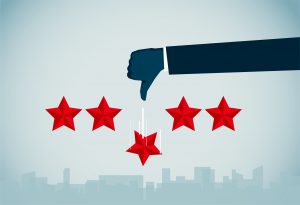
by Don Lindsey
In the processing of modern supply chains, your organization must pay particular attention to the cost of ensuring the quality of its products. Revenue will suffer if poor product quality damages your organization’s reputation.
The Cost of Quality
Cost of Quality (CoQ) is a robust way to quantify the total cost of quality-related efforts and any deficiencies in an organization in quality improvement efforts. Armand V. Feigenbaum first described the Cost of Quality in a 1956 Harvard Business Review article you can find here.
While Cost of Quality is an effective measure of identifying cash drains, it can also be used to balance the price-quality relationship of products. On your trip to the store, you know that the more expensive product generally is the winner in terms of quality and durability when comparing two similar products. Part of the goal of Cost of Quality is to identify and reduce the costs involved with producing the product and therefore maximizing revenue.
The same is true in the manufacturing process. To build a product that is superior to its rivals, you will often have to be willing to invest more in its production. The increased cost needs to be covered, but at the same time, businesses need to stay competitive in their prices – excellent quality does not mean anything if a product is not affordable to a price-sensitive target market.
Companies with similar products and comparable marketing strengths compete in the market. The company that measures its Cost of Quality and uses it to improve its product is more likely to have an increased margin.
Measuring the Cost of Quality
The Cost of Quality is a method used to measure:
- the cost of resources used to maintain the quality of products, known as Cost of Good Quality (CoGQ)
- the costs incurred due to internal and external failures, known as Cost of Poor Quality (COPQ)
The Total Cost of Quality is calculated by simply adding the Cost of Good Quality (CoGQ) and the Cost of Poor Quality (CoPQ):
CoQ = CoGQ + CoPQ
Your first step in calculating the Cost of Quality is identifying the cost types (CoGQ or CoPQ). Then within the ERP database, both operational and financial, locate the data elements that capture those values, which help sum up the Cost of Quality.
Cost of Good Quality = Prevention costs + Appraisal costs
Prevention Costs are those that are incurred to prevent poor quality and product failures. These include costs from:
- Product Specifications and Standards. Manufacturing Engineers, Documentation in 1.4.1 – Item Master Data, 13.5 – Product Structure Data, and 14.13.1 – Routing Maintenance. This data can be coupled with Comments and attached documents as required.
- Product Development. R&D and Product Transfer departments transfer products and formalize data movement from the R&D to manufacturing organizations.
- Quality Planning. Quality processes, quality applications, and quality data for the organization.
- Quality Assurance. Testing products to prevent defects from reaching the customer.
- Risk management. Costs that identify tool records maintained and facilities or machines used to prevent defective products.
- Training Costs. Human Resource efforts to train individuals. An informed employee is less likely to create defective products.
- Supplier Qualification Cost. Including Travel Costs, Testing, and Shipping. Since we do not have immediate control over the suppliers of the components in raw material, this also includes supplier certification programs and communication costs.
- Other appropriate processes you might use in your environment to prevent defects.
Appraisal costs include those incurred during product reviews and audits and production processes to ensure they conform to quality standards. These may include:
- Inspections of Received Goods. The number of PO Receipts per Period, cost of Receiving, and Put Away. You can measure instances of inventory received with the 3.21.2 – Transaction by Item data. You can track the results of the quality reviews of your received goods and in-process (appraisal costs) and your finished goods (internal failure) Through the inspection functionality.
- Testing. Equipment and Maintenance. Enterprise asset management or quality systems can be appropriated to appraisal costs.
- Process Monitoring. Equipment and equipment monitoring with digital sensors and counting apparatus should be included in your appraisal cost.
- Audits. Travel costs, support to auditors, and administrative costs. Financial and operations audits and the actual results of operations projects and financial results should be considered in your appraisal cost calculations.
- Supplier Performance Management. Administrative, data collection costs, and travel costs. The cost of measuring your supplier’s activity regarding your requirement
- s through the use of a supplier performance application will be part of your appraisal.
- Other appropriate processes you might use in your environment to prevent defects.
The Cost of Poor Quality (COPQ) comprises those costs incurred due to bad practices, failures, and low product quality. There are both internal and external failure costs. The math, again, is elementary.
- CoPQ = Internal failure costs + external failure costs
- Internal failure costs are related to the low quality of a product detected before it is shipped. These include:
- Unforeseen waste and scrap and failure analysis costs. You can track scrap planned vs. scrap actual through op_hist and tr_hist.
- Re-work of Production Orders [type R] result in variance product received from Production Order vs. Cost of Material and Labor required for the Rework. The use of 16.13.1 – Order Type R can capture Rework Costs.
- Machinery breakdown attributable to substandard maintenance. You can monitor this through Reason Code Downtime monitoring.
- Cost of items not included in your Internal Failure Cost. You can trace these through tr_hist.
- Monitoring internal failures. Cost of Inspectors, Cost of Equipment, and Transactional Cost.
- Discarded write-offs. You can track through the general ledger transactions.
- Other appropriate processes you might use in your environment to prevent defects.
External failure costs are related to the low quality of a product detected by the customer after being shipped. These include:
- Returns of RMA processed. 11.7.1.1 – RMA maintenance or 11.7.2.1 – RTS maintenance would include these costs. The RMA functionality helps the organization manage and keep track of returns, repairs, and replacements (external failures) demanded by your customers.
- Product recalls. Cost of Replacement, Due Diligence, Scrap, and Rework all contribute to External Failure Cost. You might want to visit this article Are You Ready for a Recall?
- Service and repairs. Calls, Call Activity Recording, Call Invoice recording, and Maintenance Complaints are all activities recorded in 11.1.1.1 – Call Maintenance.
- Warranty claims. Return Material Authorizations and Warranty Charges from GL are all visible thru 11.3.15 – Warranty Type Maintenance.
- Other appropriate processes you might use in your environment to prevent defects.
An Example of a Cost of Poor-Quality Calculations
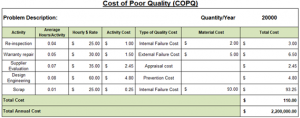
Note the inclusion of Internal Failure Cost, External Failure Cost, Appraisal Cost, and Prevention Cost in the calculations.
Types of Cost in Cost of Quality
You can use the graph below to determine the type of cost.
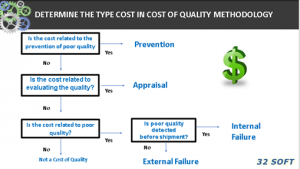
Of all the subcategories of Cost of Quality, an American Society for Quality analysis shows that External Failure Costs are the most expensive. Estimates state that 10-15% of the average company’s operating expenses (and as much as 40% in some companies) are due to the cost of poor quality. Failure costs rise much higher than prevention costs, so investing in preventive measures will help you minimize failure costs.
Using the Cost of Quality measurement method over time could prove to be a valuable addition to your cost-cutting quiver.
An ERP/MRP [QAD] system Can Oversee Some Quality Costs
Although an ERP/MRP System will not calculate the Total Cost of Quality on its own, the data and calculations in your system help you track types of quality costs and implement preventive measures.
CoQ’s primary use of the ERP tool and MRP system lies in its capabilities to organize and standardize data and processes and provide a model to support the implementation of procedures that prevent failures. If you can make MRP work properly, you can control the manufacturing engine.
Here are examples of tools in QAD you can use to measure various Cost Types in the Cost of Quality calculation:
11.7.1.1 – RMA Maintenance – External Failure

16.3.1 – Production Order Maintenance – Internal Failure
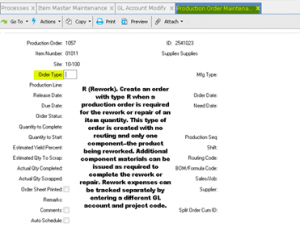
16.13.15 – Scrap Transaction – Internal Failure
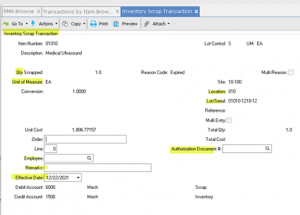
13.5 – Product Structure
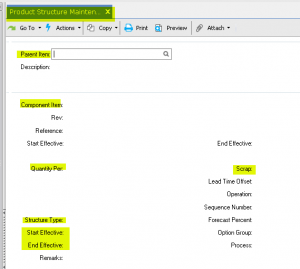
14.5 – Work Center Definition – Cost of Quality Data
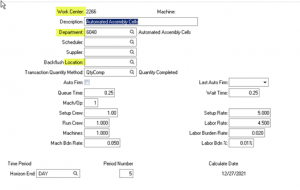
14.13.1 – Routing Data Maintenance– Cost of Quality Data
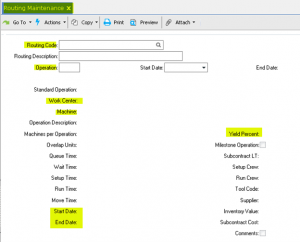
Item Master Maintenance– Cost of Quality Data
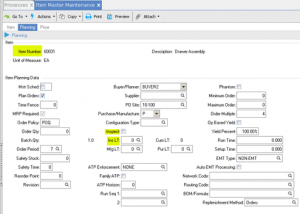
Although most data required for Cost of Quality comes from the operational side of your ERP system, you will find the Financial data of excellent assistance in calculations.
Cost of Quality regarding balance sheet and Income Statements can include GL Account Types, Shared Set and Profile Codes. You can use financial data for Cost Types such as internal Failure costs and some elements of Prevention and Appraisal Cost. You can use values such as Overhead Costs, Labor Values, and other pertinent information found in General Ledger.
The SAF Supplemental Analysis Code can be an excellent way to categorize values in the Business Relationship menu to assist with measuring the Cost of Quality.
Conclusion
The Cost of Quality method allows your organization to find that measured balance between the price of your product and its quality. It provides the necessary insight to identify quality problem areas and related costs. Consequently, you can analyze the root causes of product non-conformance and determine how to allocate resources so you can improve your production processes and product quality. An investment in prevention can minimize failure and appraisal costs.
Minimizing external failures will lower the rate of returns and repairs and increase revenues and customer satisfaction.
Measuring your Cost of Quality can significantly impact your business’s bottom line. If done right and used in conjunction with a viable ERP software application, implementation Cost of Quality could dramatically contribute to the amelioration and standardization of your manufacturing processes and the long-term health and growth of your company.
Don Lindsey, CFPIM, CIRM is a knowledgeable Implementation Project Manager, Trainer, and Business Analyst for all areas of QAD. He has been an implementation manager on several large, complex MFG/PRO projects, and has worked with the QAD system since 2007 in Manufacturing, Systems Management, Service & Support, and Finance. Don has a diversified background in a wide variety of manufacturing industries from Medical to Electronics to Industrial to Consumer Products. He has spoken for many years at the APICS Conferences, having taught in the APIC Certification program at California State University @ Fullerton for more than 20 years.
Recommended Reading: How ERP Software Impacts Quality

